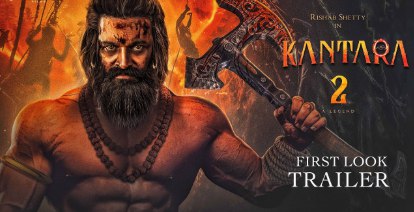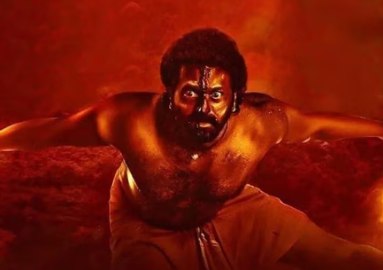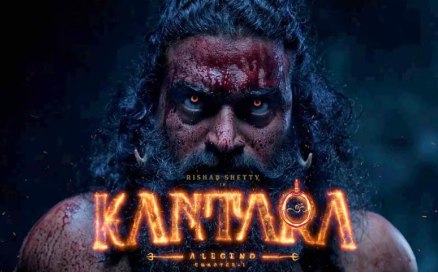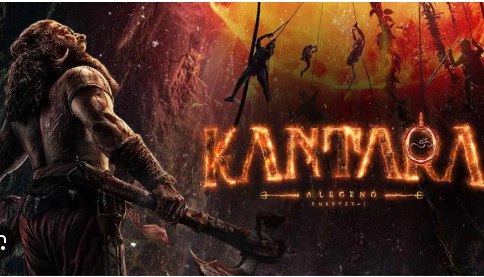Kantara: Chapter 2 Review

Kantara: Chapter 2 Review
Film: Kantara: Chapter 1
Cast: Rishab Shetty, Rukmini Vasanth, Jayaram, Gulshan Devaiah & ensemble
Written & Directed by: Rishab Shetty
Produced by: Hombale Films
Rating: ★★★★☆ (4/5)
Attempting a prequel to a phenomenon like Kantara is like walking into a storm by choice. To write it, direct it, and lead it as an actor is a triple gamble that few filmmakers would dare. Yet Rishab Shetty does not just step into that challenge—he transforms it into a passionate pursuit. Where the original film arrived unexpectedly and shook the cultural imagination, Kantara: Chapter 1 arrives with intent, fully aware of its legacy and unafraid of the scrutiny. It is not simply another installment; it is a cinematic invocation.
The Story – A Journey to Origins
Unlike the first Kantara, which built its tension around folklore and faith in a contemporary rural setting, this chapter takes audiences back thousands of years, rooting itself in the soil of myth and memory. At the center of the tale is a king, arrogant in his disbelief, who mocks the celestial protectors—Eshwara’s Ganas. His hubris summons his downfall when Guliga ensnares him, and a sinister darkness consumes his reign. Out of this ruin survives a child, bearing the weight of ancestral devastation.
The saga then moves into the reign of Rajashekhara, who tries to heal a civilization scarred by fear, and later to Kulashekhara, his heir, who rules with indulgence and excess. Running parallel is the story of Berme, a tribal child nurtured in sacred protection, who grows into a man molded by ritual, resilience, and rebellion. These two streams—the corrupted monarchy and the spiritual resistance—run alongside each other until they inevitably collide. The film thrives on this duality, its rhythm like two drums finding harmony after a long discord.
Direction & Vision
Rishab Shetty’s ambition is evident in every frame. He does not approach this as a conventional period drama but as a myth unfolding before the viewer. Where many filmmakers falter in balancing spectacle and intimacy, Shetty manages to elevate both. He expands the world into something vast and atmospheric yet never forgets the human pulse that made Kantara resonate.
The decision to move backward in time and tell an origin story is risky—it removes the safety net of nostalgia and demands complete reinvention. But Shetty turns that risk into an opportunity. By weaving together myth, folklore, and oral tradition, he creates a cinematic tapestry that feels both ancient and immediate.

Cinematography & Visual Craft
Arvind S. Kashyap’s cinematography deserves its own chapter in this saga. The lens captures temples, forests, plains, and flames with painterly patience. Every frame is infused with texture—sweat on a warrior’s brow, flickering ritual fires, trembling leaves in a storm. The camera lingers, allowing the viewer to soak in the atmosphere, and in doing so, it breathes life into the mythic world.
Visual effects are used with restraint, almost tricking the eye into believing they are real. Creatures and mythological presences—whether animals in motion or the terrifying Brahmarakshas—emerge with a balance of spectacle and believability. The practical stunts, earthy choreography, and raw action sequences anchor the film to reality, even as it soars into the supernatural.
Sound & Music – The Heartbeat of Ritual
Shetty understands that sound is as vital as image in creating immersion. The drumbeats in Kantara: Chapter 1 do not merely accompany the visuals—they narrate, they warn, they elevate. The score enters at moments of highest tension, amplifying emotions without tipping into melodrama. There are silences too, deliberate pauses that allow scenes to simmer instead of rushing them.
The sound design does more than fill the space; it creates the space. When chants echo, when wind roars, when a crowd gasps, the theatre itself seems to vibrate. Watching this film in a silent room would rob it of half its spirit—the auditory immersion is inseparable from its experience.
Performances
Rishab Shetty as Berme
The film ultimately belongs to Rishab Shetty, who as Berme delivers a performance that is both feral and fragile. His physicality is commanding—every possession scene, every ritual gesture feels lived, not performed. It is as if he channels an ancestral energy rather than merely acting. His Berme is the heart of the legend: a man torn between reverence and rebellion, his body and spirit becoming vessels for myth.
Rukmini Vasanth as Kanakavathi
Rukmini Vasanth is the revelation of this chapter. What could have been a decorative role instead becomes pivotal. She plays Kanakavathi with quiet strength, layering tenderness with resilience. She refuses to fall into clichés of ornamental femininity, choosing instead to portray a woman of substance, patience, and hidden steel. Her small gestures speak volumes, and her presence anchors several emotional beats.
Gulshan Devaiah as Kulashekhara
Gulshan Devaiah lends the monarch both menace and wit. His indulgence is not one-note; he makes the character frightening yet strangely charismatic. His ease with Kannada adds authenticity, and his balance of humor and cruelty makes Kulashekhara unpredictable.
Supporting Cast
The ensemble deserves equal praise. From the extras who populate villages and rituals to the actors in smaller roles, every performance feels organic. They are not background figures but part of a living community. Animal handlers and stunt performers, too, contribute to making the world breathe with real danger and tension.

Strengths & Shortcomings
The film is ambitious, but ambition often brings indulgence. The first half lingers heavily on textures, conversations, and playful banter, sometimes slowing the momentum. The tonal shift from humor to dread is sudden, and a tighter screenplay could have smoothed this transition. Certain emotional beats, too, feel stretched, and trimming them might have heightened the stakes.
Yet, these are minor fractures on a massive structure. The grandeur and sincerity of Shetty’s vision overshadow its imperfections. What the film offers—visually, emotionally, and culturally—far outweighs its flaws.
The Big Screen Experience
Kantara: Chapter 1 is cinema designed for the theatre. To watch it on a phone or laptop would be to strip it of half its soul. The sound of drums, the echo of chants, the roar of crowds, and the sweep of landscapes demand the auditorium’s scale. The film thrives in shared spaces, where gasps, laughter, and silence ripple through an audience like a collective ritual.
The IMAX experience, in particular, magnifies its immersive quality. Every ritual becomes communal, every battle larger than life. This is not merely a film—it is a cultural performance, one that blossoms in the shared breath of a crowd.
Final Verdict
Despite its flaws, Kantara: Chapter 1 is a bold, immersive, and courageous act of cinema. Rishab Shetty proves himself not only as a storyteller but as a performer who can hold both intimacy and spectacle within his grasp. Backed by a team of dedicated technicians, performers, and artisans, he crafts a film that feels as vast as myth and as immediate as a heartbeat.
Some will find it indulgent, others will call it audacious, but no one can deny its craft or its ambition. It is a film that will spark conversations, analyses, and debates. More importantly, it is proof that regional cinema can dream as expansively as any global blockbuster while staying rooted in its own soil.

Verdict: Watch it in theatres. Feel its drums in your chest. Let its echoes haunt you. This is cinema that lingers long after you leave the hall. Stay tuned and connected with Roj Ka Drama for further updates!
Read More